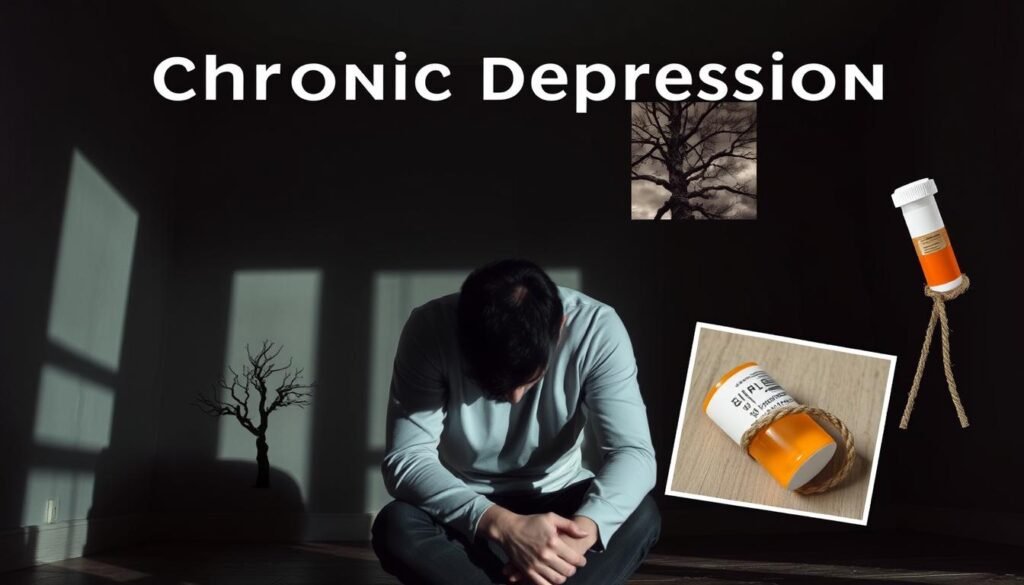Have you ever wondered why some people feel persistently low, even when life seems fine? This long-term mood disorder, often misunderstood, affects 1.5% of U.S. adults. It’s more than just temporary sadness—it’s a complex mental health condition that requires attention and care.
This article dives into the causes, symptoms, and modern treatment approaches for this condition. We’ll explore how biological factors play a role and why early intervention is crucial. By debunking myths and offering actionable strategies, we aim to provide clarity and support for those affected.
Understanding the difference between a persistent disorder and temporary sadness is key. With the right knowledge, managing this condition becomes more achievable. Let’s explore how to identify the signs and take steps toward better mental health.
Key Takeaways
- Chronic depression is a long-term mental health condition affecting many adults.
- Biological factors and emotional symptoms play a significant role.
- Early intervention can prevent major depressive episodes.
- Modern treatment approaches offer effective management strategies.
- Understanding the difference between persistent disorder and temporary sadness is crucial.
What is Chronic Depression?
What does it mean to live with a persistent low mood that doesn’t seem to fade? This condition, known as persistent depressive disorder, is a long-term mental health issue that affects many people. Unlike temporary sadness, it lasts for two years or more, making it a significant challenge for those who experience it.

Understanding Persistent Depressive Disorder
Persistent depressive disorder, also called dysthymia, is defined by the DSM-5 as a mood disorder with mild to moderate symptoms. These symptoms include low energy, feelings of hopelessness, and difficulty concentrating. While not as severe as major depression, it can still disrupt daily life and relationships.
One unique aspect of this disorder is the risk of developing double depression. This occurs when a person with dysthymia experiences a major depressive episode. Studies show that 20-30% of people with persistent depressive disorder develop this comorbidity, making treatment more complex.
Chronic Depression vs. Major Depressive Disorder
While both conditions fall under the umbrella of depressive disorders, they differ in intensity and duration. Major depressive disorder involves severe symptoms that last for at least two weeks. In contrast, persistent depressive disorder is characterized by milder symptoms that persist for two years or more.
Another key difference is the absence of manic phases, which distinguishes it from bipolar spectrum disorders. This makes accurate diagnosis crucial, as symptoms of persistent depressive disorder can often be normalized or overlooked. Understanding these distinctions helps in identifying the right treatment approach.
Causes of Chronic Depression
Why do some individuals struggle with long-term emotional challenges despite external stability? The causes are often complex, involving a mix of genetic, biological, and environmental factors. Understanding these can help in identifying effective treatment strategies.

Genetic Factors and Family History
Research shows that genetic factors play a significant role in emotional health. Twin studies reveal a heritability rate of around 40%, indicating a strong genetic predisposition. If someone in your family has experienced similar challenges, you may be at a higher risk.
Brain Chemistry and Mood Regulation
The brain’s chemical balance is crucial for emotional stability. Dysfunctions in neurotransmitters like serotonin and norepinephrine can disrupt mood regulation. These imbalances often contribute to prolonged emotional struggles, making treatment essential.
Environmental and Psychological Triggers
External factors, such as prolonged stress, can significantly impact emotional health. Chronic stress increases the risk of developing long-term challenges by three times. Childhood trauma, high-risk professions, and caregiving responsibilities are also common triggers.
Symptoms of Chronic Depression
How do persistent emotional struggles manifest in daily life? Recognizing the symptoms is the first step toward understanding and addressing this condition. These signs can affect emotions, behavior, physical health, and relationships.
Emotional and Behavioral Symptoms
One of the most common emotional symptoms is anhedonia, the inability to feel pleasure in activities once enjoyed. Persistent feelings of hopelessness and sadness often dominate daily thoughts. Behavioral changes, such as social withdrawal and irritability, are also common.
Studies show that 83% of individuals report cognitive impairment, including difficulty concentrating and making decisions. These challenges can make even simple tasks feel overwhelming.
Physical Symptoms and Sleep Disturbances
Physical symptoms often accompany emotional struggles. Many experience changes in sleep patterns, such as insomnia or hypersomnia. Chronic pain, digestive issues, and low energy levels are also frequently reported.
Psychomotor changes, like slowed movements or restlessness, affect 68% of individuals. These physical manifestations can further complicate daily life.
Impact on Daily Life and Relationships
The effects of this condition extend beyond the individual. Workplace productivity often declines, with many struggling to meet professional demands. Relationships can also suffer, as marital strain and social withdrawal become more prevalent.
Understanding these symptoms helps in identifying the condition early. Early intervention can prevent further complications and improve quality of life.
Diagnosing Chronic Depression
How do professionals determine if someone is experiencing a long-term emotional struggle? Accurate diagnosis is essential for effective treatment. This process involves a thorough evaluation by a mental health provider, including a detailed history and specific tests.

Clinical Evaluation and Mental Health History
A mental health provider begins with a comprehensive clinical evaluation. This includes discussing symptoms, their duration, and how they impact daily life. The history helps identify patterns and potential triggers, such as family background or past trauma.
The 5-axis assessment process is often used. It evaluates clinical disorders, personality issues, medical conditions, psychosocial stressors, and overall functioning. This holistic approach ensures no aspect of the individual’s health is overlooked.
Persistent Depressive Disorder Test
Tools like the PHQ-9 are commonly used for diagnosis. This questionnaire assesses the severity of symptoms over the past two weeks. Scores help determine if the individual meets the criteria for persistent depressive disorder.
Lab tests, such as thyroid function checks and vitamin deficiency screenings, are also conducted. These rule out physical conditions that might mimic emotional symptoms.
Differentiating from Other Mood Disorders
It’s crucial to distinguish persistent depressive disorder from other disorders. For example, bipolar II involves episodes of hypomania, which are absent in persistent depressive disorder. The DSM-5 and ICD-11 provide specific criteria for accurate differentiation.
Comorbidity with anxiety disorders is common, affecting 58% of individuals. This makes a thorough evaluation even more important to address all underlying issues.
Effective Treatments for Chronic Depression
What are the most effective ways to address persistent emotional challenges? Modern approaches focus on a mix of therapy, antidepressants, and combination strategies. These methods aim to improve emotional health and reduce the effects of long-term mood struggles.

Psychotherapy: Cognitive Behavioral and Interpersonal Therapy
Cognitive Behavioral Therapy (CBT) is one of the most effective treatments, with a 60% remission rate. It focuses on identifying and restructuring negative thought patterns. Techniques include journaling, behavioral activation, and problem-solving skills.
Interpersonal Therapy (IPT) addresses relationship issues that contribute to emotional struggles. It helps improve communication and resolve conflicts, making it a valuable tool for long-term management.
Antidepressants: Types and Effectiveness
Antidepressants like SSRIs and SNRIs are often the first line of treatment. SSRIs, such as fluoxetine, increase serotonin levels, while SNRIs, like venlafaxine, target both serotonin and norepinephrine. These medications can take 6-8 weeks to show full effects.
Side effects vary, with SSRIs often causing nausea and SNRIs linked to increased blood pressure. However, they remain a cornerstone of treatment for many individuals.
Combination Therapy: Psychotherapy and Medication
Studies like the STAR*D trial show that combining therapy and antidepressants yields better outcomes than either approach alone. This combination addresses both the biological and psychological aspects of emotional challenges.
Adjunct therapies, such as Transcranial Magnetic Stimulation (TMS) and ketamine, are also gaining attention. These options provide additional support for those who don’t respond to traditional treatments.
Lifestyle Changes to Manage Chronic Depression
Making small but impactful changes in daily habits can significantly improve emotional well-being. By focusing on nutrition, physical activity, and stress management, individuals can create a healthier routine that supports mental health. These changes not only reduce symptoms but also enhance overall quality of life.

Importance of Diet and Exercise
A balanced diet plays a crucial role in emotional health. The Mediterranean diet, rich in fruits, vegetables, and healthy fats, has been shown to reduce the risk of emotional challenges by 33%. This diet supports the gut-brain axis, which influences mood and stress levels.
Regular exercise is equally important. The standard recommendation is 150 minutes of moderate activity per week. Activities like walking, yoga, or cycling can boost endorphins and improve overall well-being. Starting with small, achievable goals can make it easier to stick to a routine.
Sleep Hygiene and Stress Management
Good sleep hygiene is essential for emotional stability. Establishing a consistent bedtime routine and avoiding screens before bed can improve sleep quality. Stimulus control techniques, like using the bed only for sleep, can also help.
Managing stress is another key factor. Mindfulness-based stress reduction (MBSR) techniques, such as meditation and deep breathing, can lower stress levels. These practices help calm the mind and improve focus throughout the day.
Avoiding Alcohol and Recreational Drugs
Substance use can worsen emotional challenges. Avoiding alcohol and recreational drugs is crucial for maintaining mental health. These substances can disrupt brain chemistry and increase the risk of relapse.
Building a relapse prevention plan can help individuals stay on track. This includes identifying triggers, seeking support, and finding healthier coping mechanisms. Small steps can lead to lasting changes in emotional well-being.
Support Systems and Chronic Depression
How can a strong support system make a difference in managing long-term emotional challenges? A reliable network of family, friends, and community resources can provide the emotional and practical help needed to navigate difficult times. Studies show that 70% of individuals experience better adherence to treatment plans when their loved ones are involved.

Role of Family and Friends
Loved ones play a crucial part in providing emotional support. Caregivers trained in active listening techniques can better understand and respond to the needs of those struggling. Simple things like regular check-ins and open communication can create a safe space for expressing feelings.
Support Groups and Community Resources
Support groups, such as those offered by NAMI, have been shown to significantly improve emotional well-being. These groups connect people with shared experiences, fostering a sense of belonging. Mapping local and online resources ensures access to professional guidance and peer support.
Building a Strong Support Network
Creating a reliable network involves routine social scheduling and clear communication. Developing scripts for expressing needs can make it easier to ask for help. Addressing codependency risks ensures that relationships remain healthy and balanced, contributing to a better quality of life.
Long-Term Management of Chronic Depression
Managing long-term emotional health requires consistent effort and the right strategies. Staying committed to your plan and making adjustments as needed can lead to lasting improvements. Here’s how to approach it effectively.
Sticking to Treatment Plans
Consistency is key when it comes to treatment. Whether it’s therapy, medication, or a combination of both, sticking to your plan helps maintain progress. Studies show that 85% of individuals who follow maintenance therapy experience better outcomes over years.
Creating a routine and setting reminders can make it easier to stay on track. Regular check-ins with your provider ensure that your plan remains effective and tailored to your needs.
Monitoring Symptoms and Adjusting Treatment
Tracking your symptoms over time helps identify patterns and triggers. Tools like the PHQ-9 questionnaire can provide valuable insights into your emotional state. This data allows your provider to adjust your treatment as needed.
Mood tracking apps and journals are also helpful. They make it easier to share updates with your care team and stay proactive about your health.
Preventing Relapse and Managing Episodes
Relapse prevention plans are essential for long-term success. These plans include strategies like identifying triggers, building a support network, and having an emergency crisis plan in place. Addressing negative thoughts early can prevent a full-blown episode.
If symptoms persist despite treatment, exploring alternative options like Transcranial Magnetic Stimulation (TMS) or ketamine therapy may be beneficial. Staying informed and open to new approaches ensures you’re always moving forward.
Chronic Depression in Different Demographics
How does persistent emotional health vary across different age groups and genders? Understanding these differences is crucial for effective treatment and support. Each demographic faces unique challenges and requires tailored approaches to improve their well-being.
Chronic Depression in Women
Women are twice as likely as men to experience persistent emotional struggles. Hormonal changes, particularly during pregnancy and menopause, play a significant role. These factors can trigger or worsen symptoms, making early intervention essential.
Perinatal cases, in particular, require special attention. Hormonal fluctuations during this period can lead to severe emotional challenges. Addressing these issues with targeted therapies can improve outcomes for both mothers and their families.
Chronic Depression in Children and Adolescents
In younger populations, symptoms often manifest differently. Children may exhibit irritability, academic struggles, or physical complaints rather than overt sadness. These masked symptoms can make diagnosis challenging.
Early identification is key to preventing long-term disorders. Schools and caregivers play a vital role in recognizing these signs and seeking professional help. Tailored therapies, such as play therapy, can be particularly effective for this age group.
Chronic Depression in the Elderly
For older adults, persistent emotional struggles often overlap with physical health issues. Somatic symptoms, such as chronic pain or fatigue, are common and can complicate diagnosis. Differentiating these symptoms from conditions like dementia is critical.
Age-specific treatment modifications are necessary to address the unique needs of the elderly. Combining medication with therapy and social support can significantly improve their quality of life. Cultural variances also play a role, influencing how symptoms are expressed and treated.
Myths and Misconceptions About Chronic Depression
Why do so many misunderstandings surround persistent emotional struggles? These misconceptions often prevent individuals from seeking the help they need. Addressing these myths is a crucial part of fostering understanding and reducing stigma.
Debunking Common Myths
One common myth is that emotional struggles can be cured by willpower alone. This belief ignores the biological and psychological things that contribute to these conditions. Another misconception is that situational sadness is the same as a clinical condition. While situational sadness is temporary, persistent struggles require professional intervention.
Understanding the Reality
Persistent emotional struggles are not a sign of weakness. They are complex conditions influenced by genetics, brain chemistry, and environmental factors. Recognizing this reality helps people approach treatment with compassion and understanding.
Addressing Stigma and Misunderstanding
Stigma remains a significant barrier to treatment, with 62% of individuals delaying care due to fear of judgment. Anti-stigma campaigns and sharing lived experiences can change thoughts and attitudes. Workplace accommodations and open conversations also play a vital role in reducing stigma.
Conclusion
Taking control of your emotional well-being starts with understanding your options. With a 70% success rate for treatment, there’s hope for improvement. Seeking professional guidance is a crucial first step toward better mental health.
Here are three immediate actions you can take:
1. Reach out to a licensed therapist or counselor.
2. Explore lifestyle changes like exercise and stress management.
3. Stay informed about emerging treatments, such as TMS and ketamine therapy.
If you or someone you know needs help, the National Helpline (1-800-662-HELP) is available 24/7. Remember, small steps today can lead to a healthier, more balanced life tomorrow.
FAQ
What is the difference between chronic depression and major depressive disorder?
Chronic depression, also known as persistent depressive disorder, involves long-term symptoms lasting two years or more. Major depressive disorder is characterized by intense episodes that may last weeks or months but can resolve with treatment.
Can genetics play a role in chronic depression?
Yes, family history and genetic factors can increase the risk of developing persistent depressive disorder. Researchers have found links between certain genes and mood regulation.
What are common symptoms of chronic depression?
Symptoms include a persistent low mood, loss of interest in activities, fatigue, sleep disturbances, and difficulty concentrating. These can significantly impact daily life and relationships.
How is chronic depression diagnosed?
A mental health provider evaluates symptoms, medical history, and may use specific tests to rule out other conditions. A diagnosis requires symptoms lasting at least two years.
What treatments are effective for chronic depression?
Treatments include psychotherapy like cognitive behavioral therapy, antidepressants, or a combination of both. Lifestyle changes, such as exercise and stress management, also help.
Can lifestyle changes improve chronic depression?
Yes, regular exercise, a balanced diet, good sleep hygiene, and avoiding alcohol can positively impact mood and overall mental health.
How can family and friends support someone with chronic depression?
Offering emotional support, encouraging treatment, and helping with daily tasks can make a significant difference. Joining support groups can also provide additional resources.
Is chronic depression more common in certain demographics?
Women, children, adolescents, and the elderly may experience chronic depression differently. Factors like hormonal changes, life stress, and health conditions can influence its prevalence.
Are there misconceptions about chronic depression?
Yes, some believe it’s just a phase or a sign of weakness. In reality, it’s a serious mental health condition that requires proper treatment and understanding.
How can someone manage chronic depression long-term?
Sticking to a treatment plan, monitoring symptoms, and making lifestyle adjustments are key. Regular check-ins with a mental health provider can help prevent relapse.






